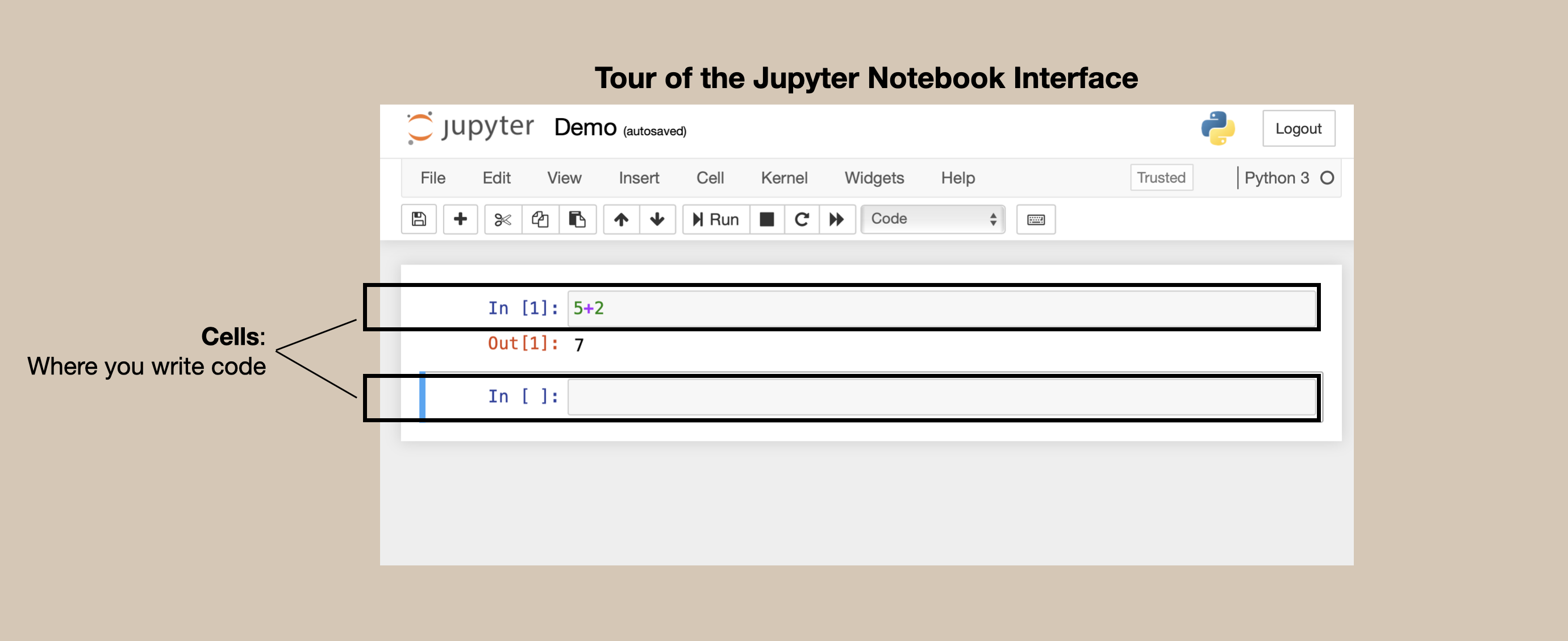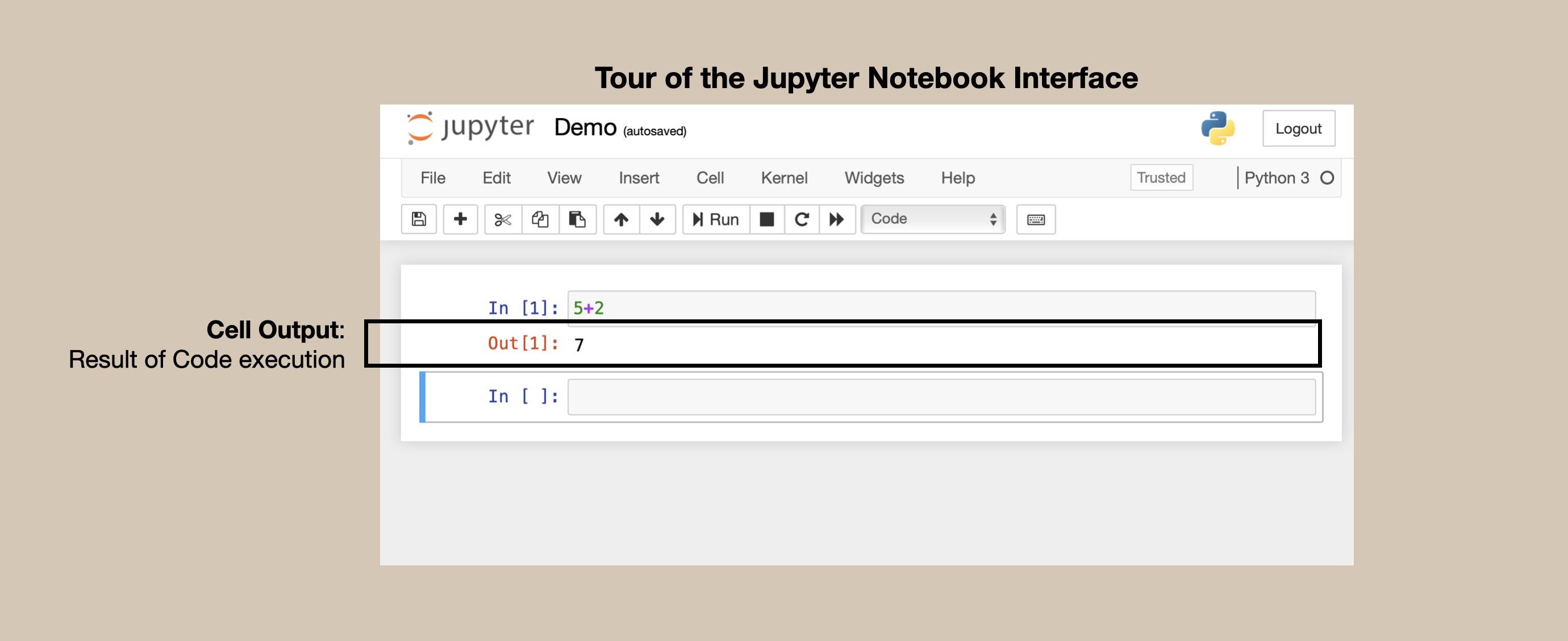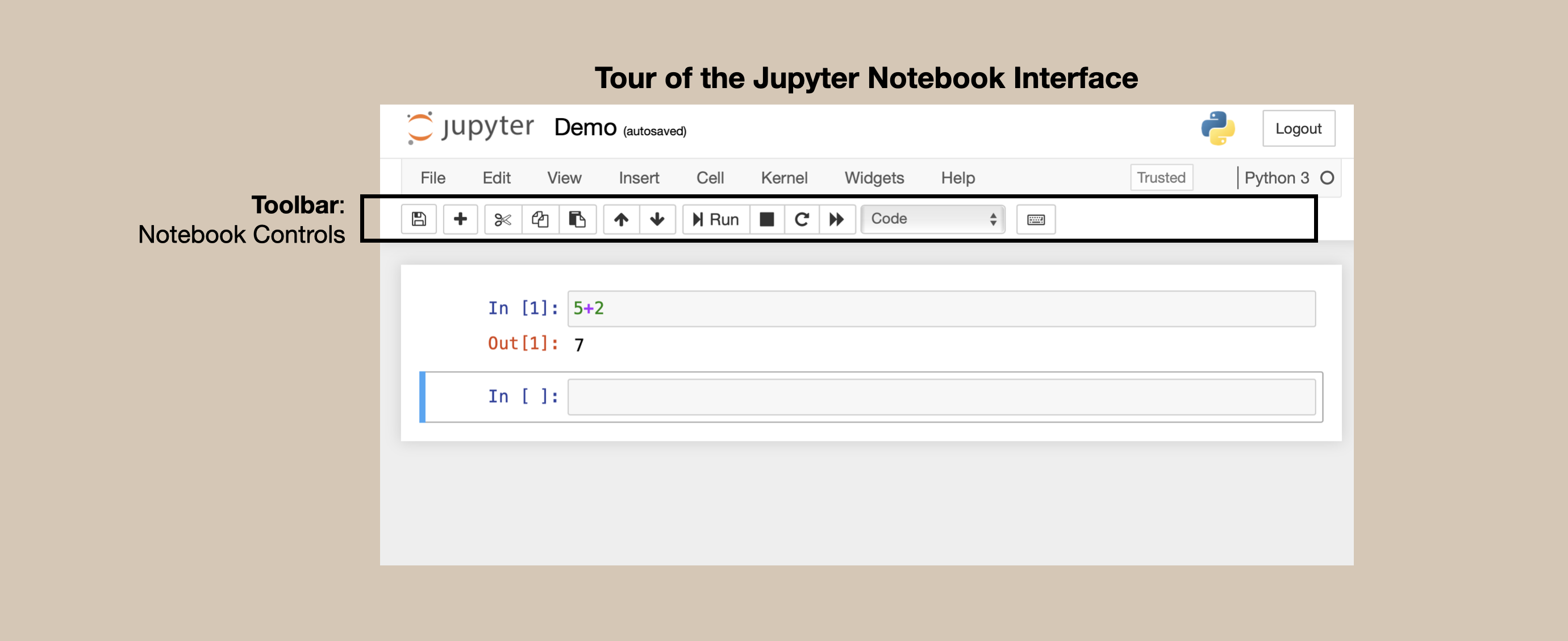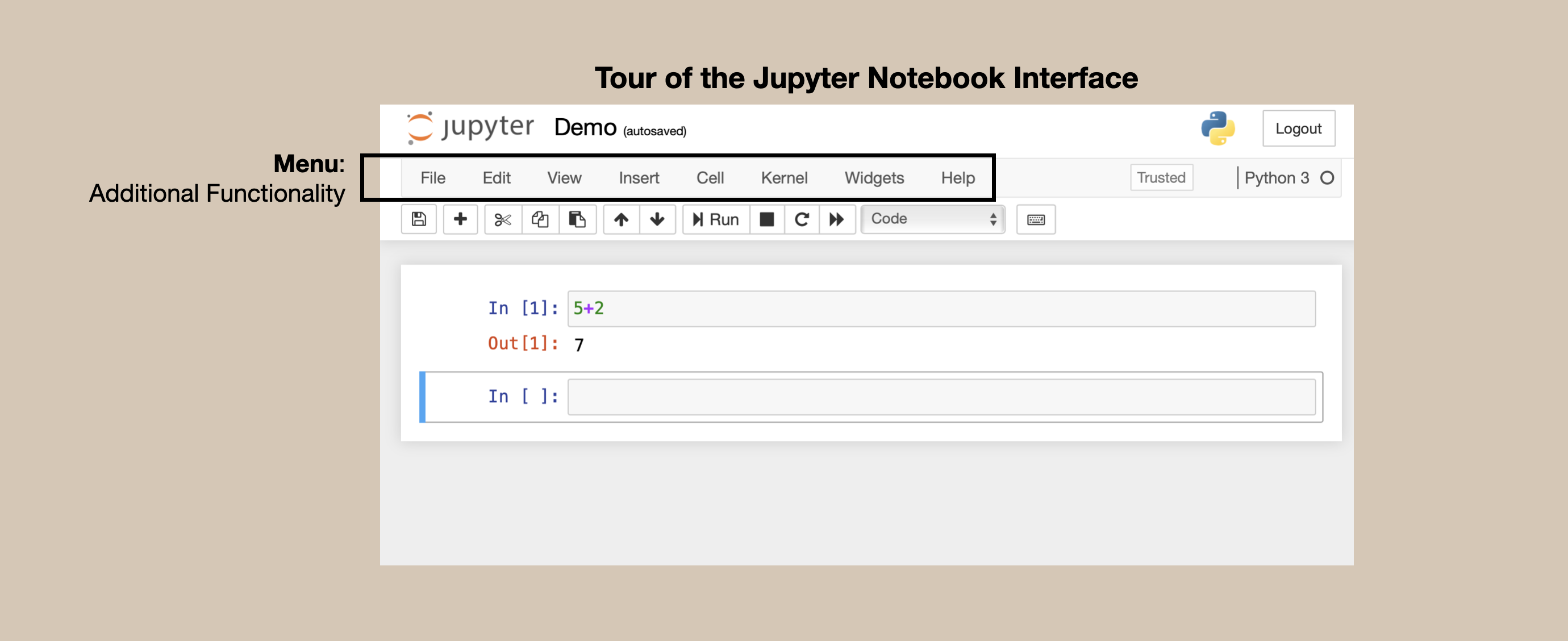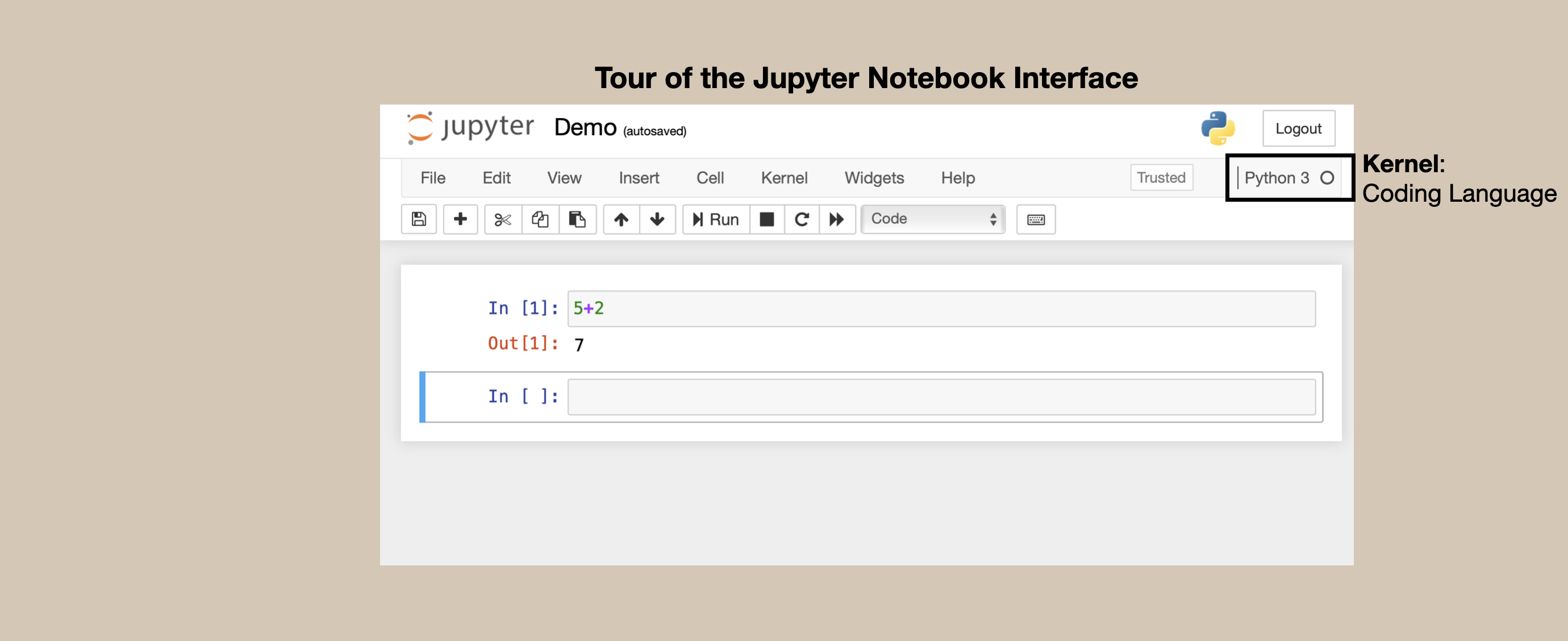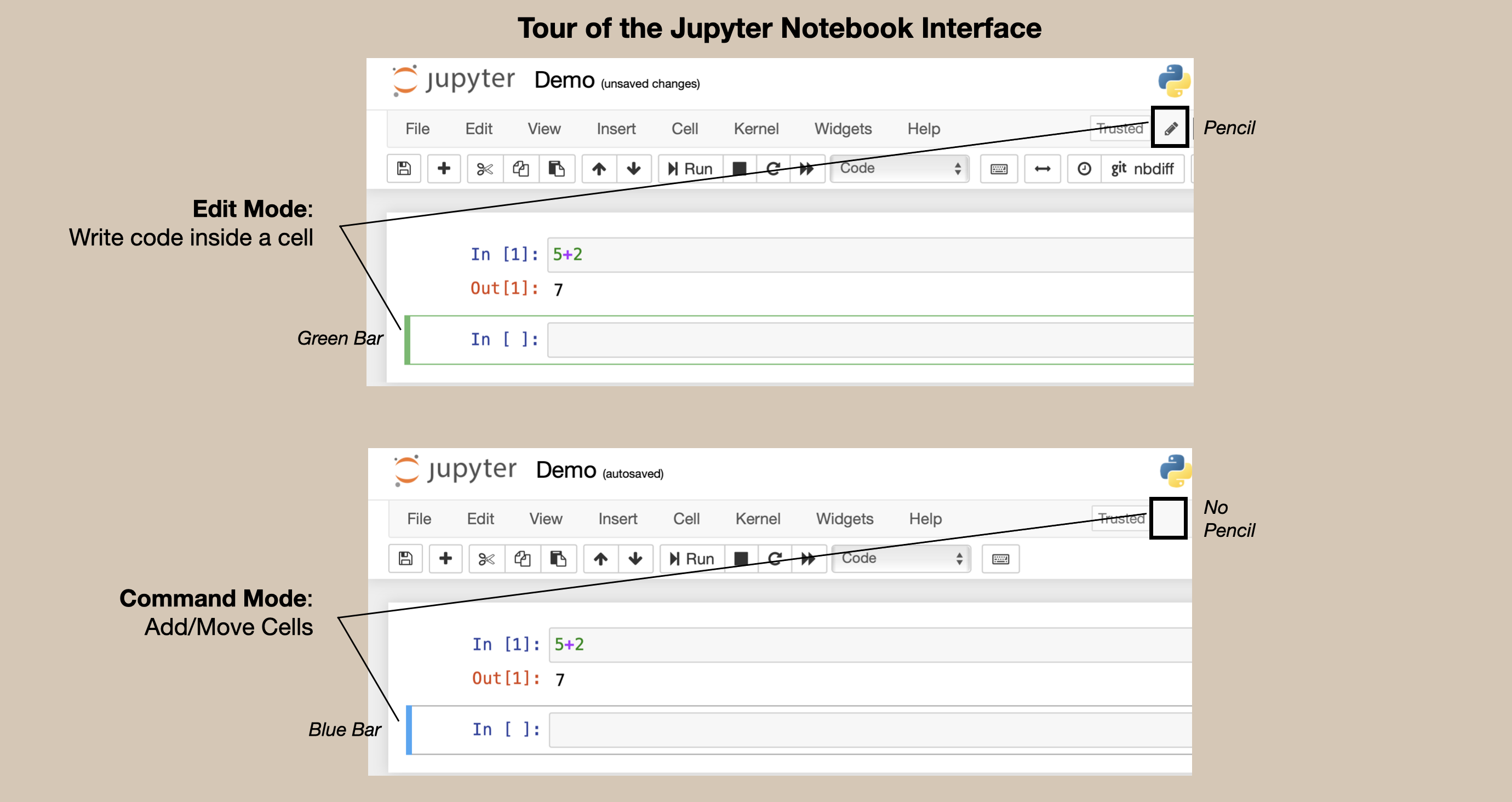Class 2A: Introduction to Programming in Python¶
We will begin at 12:00 PM! Until then, feel free to use the chat to socialize, and enjoy the music!

Firas Moosvi
Class Outline:¶
1st hour - Introduction to Python
Announcements (2 mins)
Introduction (3 mins)
Writing and Running Code (15 min)
Interpreting Code (15 min)
Review and Recap (5 min)
2nd hour - Digging Deeper into Python syntax
Basic datatypes (15 min)
Lists and tuples (15 min)
String methods (5 min)
Dictionaries (10 min)
Conditionals (10 min)
Learning Objectives¶
Become familiar with the course tools and how lectures will be run.
Look at some lines of code and predict what the output will be.
Convert an English sentence into code.
Recognize the order specific lines of code need to be run to get the desired output.
Imagine how programming can be useful to your life!
Part 2: Writing and Running code (15 mins)¶

Using Python to do Math¶
Task |
Symbol |
|---|---|
Addition |
|
Subtraction |
|
Multiplication |
|
Division |
|
Square, cube, … |
|
Squareroot, Cuberoot, … |
|
Trigonometry (sin,cos,tan) |
Later… |
Demo (side-by-side)¶
# Addition
4 + 5 +2
11
# Subtraction
4-5
-1
# Multiplication
4*5
20
# Division
10/2
5.0
# Square, cube, ...
2**3
8
# Squareroot, Cuberoot, ...
4**(1/2)
2.0
Assigning numbers to variables¶
You can assign numbers to a “variable”.
You can think of a variable as a “container” that represents what you assigned to it
There are some rules about “valid” names for variables, we’ll talk about the details later
Rule 1: Can’t start the name of a variable with a number!
General guideline for now: just use a combination of words and numbers
Demo (side-by-side)¶
# Two numbers
num1 = 4000000000000
num2 = 8
print(num1,num2)
4000000000000 8
# Multiply numbers together
num1*num2
32000000000000
Assigning words to variables¶
You can also assign words and sentences to variables!
Surround anything that’s not a number with double quotes ” and “
mysentence = "This is a whole sentence with a list of sports, swimming, tennis, badminton"
print(mysentence)
This is a whole sentence with a list of sports, swimming, tennis, badminton
Using Python to work with words¶
Python has some nifty “functions” to work with words and sentences.
Here’s a table summarizing some interesting ones, we’ll keep adding to this as the term goes on.
Task |
Function |
|---|---|
Make everything upper-case |
|
Make everything lower-case |
|
Capitalize first letter of every word |
|
Count letters or sequences |
|
Demo (side-by-side)¶
mysentence
'This is a whole sentence with a list of sports, swimming, tennis, badminton'
# split on a comma
mysentence.split(',')
['This is a whole sentence with a list of sports',
' swimming',
' tennis',
' badminton']
# make upper case
mysentence.upper()
'THIS IS A WHOLE SENTENCE WITH A LIST OF SPORTS, SWIMMING, TENNIS, BADMINTON'
# make lower case
mysentence.lower()
'this is a whole sentence with a list of sports, swimming, tennis, badminton'
# count the times "i" occurs
mysentence.count('m')
3
# count two characters: hi
mysentence.count('hi')
1
mysentence2 = " Hello. World ..... "
mysentence2
' Hello. World ..... '
mysentence2.strip(' ')
'Hello. World .....'
mysentence2.replace(' ','^')
'^^^^^Hello.^^^^^World^.....^^^^^'
Extending Python¶
Python is a very powerful programming language that allowing you to do a lot out of the box (as you saw!)
We will see lots of examples of interesting things you can do with python
But eventually, you will want to write your own functions to make specific tasks easier
To share code that others have written, they “package” it up and then “import” it so they can use it
Demo (side-by-side)¶
# Numpy is a very popular package to add many more math functions. You can import it like this:
import numpy
# pi
numpy.pi
3.141592653589793
# sin(pi)
numpy.sin(numpy.pi)
1.2246467991473532e-16
# cos(pi)
numpy.cos(numpy.pi)
-1.0
numpy.deg2rad(30)
0.5235987755982988
numpy.pi/6
0.5235987755982988
Activity: Philosophy of Python¶
There are often MANY different ways of doing things; same output, different “code”
There is a philosophy of writing python code, the “pythonic” way of doing things.
Let’s look at this philosophy a bit more carefully.
Demo (side-by-side)¶
import this
The Zen of Python, by Tim Peters
Beautiful is better than ugly.
Explicit is better than implicit.
Simple is better than complex.
Complex is better than complicated.
Flat is better than nested.
Sparse is better than dense.
Readability counts.
Special cases aren't special enough to break the rules.
Although practicality beats purity.
Errors should never pass silently.
Unless explicitly silenced.
In the face of ambiguity, refuse the temptation to guess.
There should be one-- and preferably only one --obvious way to do it.
Although that way may not be obvious at first unless you're Dutch.
Now is better than never.
Although never is often better than *right* now.
If the implementation is hard to explain, it's a bad idea.
If the implementation is easy to explain, it may be a good idea.
Namespaces are one honking great idea -- let's do more of those!
Activity Instructions¶
You will be put into breakout groups of 3-5 people
Introduce yourself! Say Hello, what year you’re in, and what program you’re from
Answer the following questions:
Why do you think these guidelines exist?
Do you think everyone follows these guidelines?
Pick one of the guidelines above and explain what you think it means.
Part 3: Interpreting code (15 mins)¶

Q1: Interpret Code¶
Look at the following code chunk, can you predict what the output will be?
some_numbers = [1, 50, 40, 75, 400, 1000]
for i in some_numbers:
print(i*5)
A. Prints 6 random numbers.
B. Prints the 6 numbers in some_numbers.
C. Prints the 6 numbers in some_numbers multiplied by 5.
D. I don’t know.
# Let's try it!
some_numbers = [1, 50, 40, 75, 400, 1000]
for i in some_numbers:
print(i*5)
5
250
200
375
2000
5000
Q2: Interpret Code¶
Look at the following code chunk, can you predict what the output will be?
some_numbers = [1, 50, 40, 75, 400, 1000]
for i in some_numbers:
if i > 50:
print(i/5)
else:
print(i)
A. Prints the 6 numbers in some_numbers.
B. Prints the number in some_numbers if it is less than 50, otherwise prints the number divided by 5.
C. Prints the number in some_numbers if it is greater than 50, otherwise print the number divided by 5.
D. I don’t know.
# Let's try it!
some_numbers = [1, 50, 40, 75, 400, 1000]
for i in some_numbers:
if i > 50:
print(i/5)
else:
print(i)
1
50
40
15.0
80.0
200.0
Q3: Interpret Code¶
Look at the following code chunk, can you predict what the output will be?
some_numbers = [1, 50, 40, 75, 400, 1000]
def process_number(number):
return (number**2)/10
for i in some_numbers:
if i > 50:
print(process_number(i))
A. Prints the number in some_numbers if it is greater than 50, otherwise prints nothing.
B. Prints the output of the process_number() function applied to some_numbers.
C. Prints the output of the process_number() function if the original number is greater than 50, otherwise prints nothing.
D. I don’t know.
# Let's try it!
some_numbers = [1, 50, 40, 75, 400, 1000]
def process_number(number):
return (number**2)/10
for i in some_numbers:
if i > 50:
print(process_number(i))
562.5
16000.0
100000.0
Q4: Order matters!¶
Suppose you are asked to complete the following operation:
Take the number 5, square it, subtract 2, and then multiply the result by 10
Does the order of the operations you do matter? Yes!
# Let's try it:
((5**2) -2)*10
230
# Here is the same operation as above but in multiple lines```
number = 5
number = number**2
number = number - 2
number = number * 10
print(number)
230
Q5: Parson’s problem¶
A Parson’s Problem is one where you are given all the lines of code to solve the problem, but they are jumbled and it’s up to you to get the right order.
A student would like to get this as the final output of some code that they are writing:
3 is smaller than, or equal to 10.
4 is smaller than, or equal to 10.
5 is smaller than, or equal to 10.
6 is smaller than, or equal to 10.
7 is smaller than, or equal to 10.
8 is smaller than, or equal to 10.
9 is smaller than, or equal to 10.
10 is smaller than, or equal to 10.
11 is bigger than 10!
12 is bigger than 10!
13 is bigger than 10!
14 is bigger than 10!
15 is bigger than 10!
Here are ALL the lines of code they will need to use, but they are scrambled in the wrong order. Can you produce the desired output?
Hint: Pay attention to the indents!
my_numbers = [3,4,5,6,7,8,9,10,11,12,13,14,15]
for i in my_numbers:
if i > 10:
print(i,'is smaller than, or equal to 10.')
else:
print(i,'is bigger than 10!')
my_numbers = [3,4,5,6,7,8,9,10,11,12,13,14,15]
for i in my_numbers:
if i > 10:
print(i,'is bigger than 10!')
else:
print(i,'is smaller than, or equal to 10.')
3 is smaller than, or equal to 10.
4 is smaller than, or equal to 10.
5 is smaller than, or equal to 10.
6 is smaller than, or equal to 10.
7 is smaller than, or equal to 10.
8 is smaller than, or equal to 10.
9 is smaller than, or equal to 10.
10 is smaller than, or equal to 10.
11 is bigger than 10!
12 is bigger than 10!
13 is bigger than 10!
14 is bigger than 10!
15 is bigger than 10!
Congratulations!!¶
You have just shown that you can program!
Over 80% of the course content will be focused on details of the things you’ve seen above:
Numbers and Strings
Loops and Conditionals
Functions
If you followed along with most of what we covered, you’re in good shape for this course

Part 4: Review and Recap (5 mins)¶

Using Python to do Math¶
Task |
Symbol |
|---|---|
Addition |
|
Subtraction |
|
Multiplication |
|
Division |
|
Square, cube, … |
|
Squareroot, Cuberoot, … |
|
Trigonometry (sin,cos,tan) |
|
Using Python to work with words (Strings)¶
Python has some nifty “functions” to work with words and sentences.
Here’s a table summarizing some interesting ones, we’ll keep adding to this as the term goes on.
Task |
Function |
|---|---|
Make everything upper-case |
|
Make everything lower-case |
|
Capitalize first letter of every word |
|
Count letters or sequences |
|
Zen of Python¶
import this produces the pythonic philosophy:
The Zen of Python, by Tim Peters
Beautiful is better than ugly.
Explicit is better than implicit.
Simple is better than complex.
Complex is better than complicated.
Flat is better than nested.
Sparse is better than dense.
Readability counts.
Special cases aren't special enough to break the rules.
Although practicality beats purity.
Errors should never pass silently.
Unless explicitly silenced.
In the face of ambiguity, refuse the temptation to guess.
There should be one-- and preferably only one --obvious way to do it.
Although that way may not be obvious at first unless you're Dutch.
Now is better than never.
Although never is often better than *right* now.
If the implementation is hard to explain, it's a bad idea.
If the implementation is easy to explain, it may be a good idea.
Namespaces are one honking great idea -- let's do more of those!
Learning Objectives¶
Become familiar with the course tools and how lectures will be run.
Describe how to use built-in python functions to do operations on numbers
Describe how to use built-in python functions to do operations on words
Look at some lines of code and predict what the output will be.
Recognize the order specific lines of code need to be run to get the desired output.
Imagine how programming can be useful to your life!
Next Hour¶
We will dive into details on more python syntax to ready ourselves for Data Analysis:
- Lists and Tuples
- String methods
- Dictionaries
- Conditionals
See you after the break!
Break¶
Attribution¶
The original version of these Python lectures were by Patrick Walls.
These lectures were delivered by Mike Gelbart and are available in their original format, publicly here.
In this class, we go through a notebook by a former colleague, Dr. Mike Gelbart, option co-director of the UBC-Vancouver MDS program.
If you prefer, you can also watch his recording of the same material.
Class Outline:¶
Basic datatypes (15 min)
Lists and tuples (15 min)
String methods (5 min)
Dictionaries (10 min)
Conditionals (10 min)
Basic datatypes¶
A value is a piece of data that a computer program works with such as a number or text.
There are different types of values:
42is an integer and"Hello!"is a string.A variable is a name that refers to a value.
In mathematics and statistics, we usually use variables names like \(x\) and \(y\).
In Python, we can use any word as a variable name (as long as it starts with a letter and is not a reserved word in Python such as
for,while,class,lambda,import, etc.).
And we use the assignment operator
=to assign a value to a variable.
See the Python 3 documentation for a summary of the standard built-in Python datatypes. See Think Python (Chapter 2) for a discussion of variables, expressions and statements in Python.
Common built-in Python data types¶
English name |
Type name |
Description |
Example |
|---|---|---|---|
integer |
|
positive/negative whole numbers |
|
floating point number |
|
real number in decimal form |
|
boolean |
|
true or false |
|
string |
|
text |
|
list |
|
a collection of objects - mutable & ordered |
|
tuple |
|
a collection of objects - immutable & ordered |
|
dictionary |
|
mapping of key-value pairs |
|
none |
|
represents no value |
|
Numeric Types¶
x = 42
print(x)
42
type(x)
int
print(x)
42
x # in Jupyter we don't need to explicitly print for the last line of a cell
42
pi = 3.14159
print(pi)
3.14159
type(pi)
float
λ = 2
Arithmetic Operators¶
The syntax for the arithmetic operators are:
Operator |
Description |
|---|---|
|
addition |
|
subtraction |
|
multiplication |
|
division |
|
exponentiation |
|
integer division |
|
modulo |
Let’s apply these operators to numeric types and observe the results.
1 + 2 + 3 + 4 + 5
15
0.1 + 0.2
0.30000000000000004
Tip
Note From Firas: This is floating point arithmetic. For an explanation of what’s going on, see this tutorial.
2 * 3.14159
6.28318
2**10
1024
type(2**10)
int
2.0**10
1024.0
int_2 = 2
float_2 = 2.0
float_2_again = 2.
101 / 2
50.5
101 // 2 # "integer division" - always rounds down
50
101 % 2 # "101 mod 2", or the remainder when 101 is divided by 2
1
None¶
NoneTypeis its own type in Python.It only has one possible value,
None
x = None
print(x)
None
type(x)
NoneType
You may have seen similar things in other languages, like null in Java, etc.
Strings¶
Text is stored as a type called a string.
We think of a string as a sequence of characters.
We write strings as characters enclosed with either:
single quotes, e.g.,
'Hello'double quotes, e.g.,
"Goodbye"triple single quotes, e.g.,
'''Yesterday'''triple double quotes, e.g.,
"""Tomorrow"""
my_name = "Mike Gelbart"
print(my_name)
Mike Gelbart
type(my_name)
str
course = 'DATA 301'
print(course)
DATA 301
type(course)
str
If the string contains a quotation or apostrophe, we can use double quotes or triple quotes to define the string.
"It's a rainy day cars'."
"It's a rainy day cars'."
sentence = "It's a rainy day."
print(sentence)
It's a rainy day.
type(sentence)
str
saying = '''They say:
"It's a rainy day!"'''
print(saying)
They say:
"It's a rainy day!"
Boolean¶
The Boolean (
bool) type has two values:TrueandFalse.
the_truth = True
print(the_truth)
True
type(the_truth)
bool
lies = False
print(lies)
False
type(lies)
bool
Comparison Operators¶
Compare objects using comparison operators. The result is a Boolean value.
Operator |
Description |
|---|---|
|
is |
|
is |
|
is |
|
is |
|
is |
|
is |
|
is |
2 < 3
True
"Data Science" != "Deep Learning"
True
2 == "2"
False
2 == 2.00000000000000005
True
Operators on Boolean values.
Operator |
Description |
|---|---|
|
are |
|
is at least one of |
|
is |
True and True
True
True and False
False
False or False
False
# True and True
("Python 2" != "Python 3") and (2 <= 3)
True
not True
False
not not not not True
True
Casting¶
Sometimes (but rarely) we need to explicitly cast a value from one type to another.
Python tries to do something reasonable, or throws an error if it has no ideas.
x = int(5.0)
x
5
type(x)
int
x = str(5.0)
x
'5.0'
type(x)
str
str(5.0) == 5.0
False
list(5.0) # there is no reasonable thing to do here
---------------------------------------------------------------------------
TypeError Traceback (most recent call last)
/tmp/ipykernel_1778/1323977772.py in <module>
----> 1 list(5.0) # there is no reasonable thing to do here
TypeError: 'float' object is not iterable
int(5.3)
5
Lists and Tuples¶
Lists and tuples allow us to store multiple things (“elements”) in a single object.
The elements are ordered.
my_list = [1, 2, "THREE", 4, 0.5]
print(my_list)
[1, 2, 'THREE', 4, 0.5]
type(my_list)
list
You can get the length of the list with len:
len(my_list)
5
today = (1, 2, "THREE", 4, 0.5)
print(today)
(1, 2, 'THREE', 4, 0.5)
type(today)
tuple
len(today)
5
Indexing and Slicing Sequences¶
We can access values inside a list, tuple, or string using the bracket syntax.
Python uses zero-based indexing, which means the first element of the list is in position 0, not position 1.
Sadly, R uses one-based indexing, so get ready to be confused.
my_list
[1, 2, 'THREE', 4, 0.5]
my_list[0]
1
my_list[4]
0.5
my_list[5]
---------------------------------------------------------------------------
IndexError Traceback (most recent call last)
<ipython-input-199-075ca585e721> in <module>
----> 1 my_list[5]
IndexError: list index out of range
today[4]
We use negative indices to count backwards from the end of the list.
my_list
[1, 2, 'THREE', 4, 0.5]
my_list[-1]
0.5
We use the colon : to access a subsequence. This is called “slicing”.
my_list[1: ]
[2, 'THREE', 4]
Above: note that the start is inclusive and the end is exclusive.
So
my_list[1:3]fetches elements 1 and 2, but not 3.In other words, it gets the 2nd and 3rd elements in the list.
We can omit the start or end:
my_list[0:3]
[1, 2, 'THREE']
my_list[:3]
[1, 2, 'THREE']
my_list[3:]
[4, 0.5]
my_list[:] # *almost* same as my_list - more details next week (we might not, just a convenience thing)
[1, 2, 'THREE', 4, 0.5]
Strings behave the same as lists and tuples when it comes to indexing and slicing.
alphabet = "abcdefghijklmnopqrstuvwyz"
alphabet[0]
'a'
alphabet[-1]
'z'
alphabet[-3]
'w'
alphabet[:5]
'abcde'
alphabet[12:20]
'mnopqrst'
List Methods (Functions)¶
A list is an object and it has methods for interacting with its data.
For example,
list.append(item)appends an item to the end of the list.See the documentation for more list methods.
primes = [2,3,5,7,11]
primes
[2, 3, 5, 7, 11]
len(primes)
5
primes.append(13)
primes
[2, 3, 5, 7, 11, 13]
len(primes)
6
max(primes)
13
min(primes)
2
sum(primes)
41
[1,2,3] + ["Hello", 7]
[1, 2, 3, 'Hello', 7]
Sets¶
Another built-in Python data type is the
set, which stores an un-ordered list of unique items.More on sets in DSCI 512.
s = {2,3,5,5,11}
s
{2, 3, 5, 11}
{1,2,3} == {3,2,1}
[1,2,3] == [3,2,1]
s.add(2) # does nothing
s
s[0]
Above: throws an error because elements are not ordered.
Mutable vs. Immutable Types¶
Strings and tuples are immutable types which means they cannot be modified.
Lists are mutable and we can assign new values for its various entries.
This is the main difference between lists and tuples.
names_list = ["Indiana","Fang","Linsey"]
names_list
['Indiana', 'Fang', 'Linsey']
names_list[0] = "Cool guy"
names_list
['Cool guy', 'Fang', 'Linsey']
names_tuple = ("Indiana","Fang","Linsey")
names_tuple
('Indiana', 'Fang', 'Linsey')
names_tuple[0] = "Not cool guy"
---------------------------------------------------------------------------
TypeError Traceback (most recent call last)
<ipython-input-236-bd6a1b77b220> in <module>
----> 1 names_tuple[0] = "Not cool guy"
TypeError: 'tuple' object does not support item assignment
Same goes for strings. Once defined we cannot modifiy the characters of the string.
my_name = "Mike"
my_name[-1] = 'q'
---------------------------------------------------------------------------
TypeError Traceback (most recent call last)
<ipython-input-238-94c4564b18e3> in <module>
----> 1 my_name[-1] = 'q'
TypeError: 'str' object does not support item assignment
x = ([1,2,3],5)
x[1] = 7
---------------------------------------------------------------------------
TypeError Traceback (most recent call last)
<ipython-input-240-415ce6bd0126> in <module>
----> 1 x[1] = 7
TypeError: 'tuple' object does not support item assignment
x
([1, 2, 3], 5)
x[0][1] = 4
x
String Methods¶
There are various useful string methods in Python.
all_caps = "HOW ARE YOU TODAY?"
print(all_caps)
HOW ARE YOU TODAY?
new_str = all_caps.lower()
new_str
'how are you today?'
Note that the method lower doesn’t change the original string but rather returns a new one.
all_caps
'HOW ARE YOU TODAY?'
There are many string methods. Check out the documentation.
all_caps.split()
['HOW', 'ARE', 'YOU', 'TODAY?']
all_caps.count("O")
3
One can explicitly cast a string to a list:
caps_list = list(all_caps)
caps_list
['H',
'O',
'W',
' ',
'A',
'R',
'E',
' ',
'Y',
'O',
'U',
' ',
'T',
'O',
'D',
'A',
'Y',
'?']
len(all_caps)
18
all_caps = all_caps + 'O' + 'o'
all_caps.count('O')
4
len(caps_list)
18
String formatting¶
Python has ways of creating strings by “filling in the blanks” and formatting them nicely.
There are a few ways of doing this. See here and here for some discussion.
Old formatting style (borrowed from the C programming language):
F-Strings (aka magic)¶
New formatting style (see this article):
name = "Sasha"
age = 4
template_new = f"Hello, my name is {name}. I am {age} years old."
template_new
'Hello, my name is Sasha. I am 4 years old.'
Dictionaries¶
A dictionary is a mapping between key-values pairs.
house = {'bedrooms': 3,
'bathrooms': 2,
'city': 'Vancouver',
'price': 2499999,
'date_sold': (1,3,2015)}
condo = {'bedrooms' : 2,
'bathrooms': 1,
'city' : 'Burnaby',
'price' : 699999,
'date_sold': (27,8,2011)
}
We can access a specific field of a dictionary with square brackets:
house['price']
2499999
condo['price']
699999
condo['city']
'Burnaby'
We can also edit dictionaries (they are mutable):
condo['price'] = 5 # price already in the dict
condo
{'bedrooms': 2,
'bathrooms': 1,
'city': 'Burnaby',
'price': 5,
'date_sold': (27, 8, 2011)}
condo['flooring'] = "wood"
condo
{'bedrooms': 2,
'bathrooms': 1,
'city': 'Burnaby',
'price': 5,
'date_sold': (27, 8, 2011),
'flooring': 'wood'}
We can delete fields entirely (though I rarely use this):
del condo["city"]
condo
{'bedrooms': 2,
'bathrooms': 1,
'price': 5,
'date_sold': (27, 8, 2011),
'flooring': 'wood'}
condo[5] = 443345
condo
{'bedrooms': 2,
'bathrooms': 1,
'price': 5,
'date_sold': (27, 8, 2011),
'flooring': 'wood',
5: 443345}
condo[(1,2,3)] = 777
condo
{'bedrooms': 2,
'bathrooms': 1,
'price': 5,
'date_sold': (27, 8, 2011),
'flooring': 'wood',
5: 443345,
(1, 2, 3): 777}
condo["nothere"]
---------------------------------------------------------------------------
KeyError Traceback (most recent call last)
<ipython-input-20-aec15e89a3c8> in <module>
----> 1 condo["nothere"]
KeyError: 'nothere'
A sometimes useful trick about default values:
condo["bedrooms"]
2
is shorthand for
condo.get("bedrooms")
2
With this syntax you can also use default values:
condo.get("bedrooms", "unknown")
2
condo.get("fireplaces", "unknown")
'unknown'
Empties¶
lst = list() # empty list
lst
lst = [] # empty list
lst
tup = tuple() # empty tuple
tup
tup = () # empty tuple
tup
dic = dict() # empty dict
dic
dic = {} # empty dict
dic
st = set() # emtpy set
st
st = {} # NOT an empty set!
type(st)
st = {1}
type(st)
Conditionals¶
Conditional statements allow us to write programs where only certain blocks of code are executed depending on the state of the program.
Let’s look at some examples and take note of the keywords, syntax and indentation.
Check out the Python documentation and Think Python (Chapter 5) for more information about conditional execution.
name = input("What's your name?")
if name.lower() == 'mike':
print("That's my name too!")
elif name.lower() == 'santa':
print("That's a fun name.")
else:
# print("Hello {}! That's a cool name.".format(name))
print(f"Hello {name}! That's a cool name.")
print('Nice to meet you!')
What's your name?Firas
Hello Firas! That's a cool name.
Nice to meet you!
bool(None)
The main points to notice:
Use keywords
if,elifandelseThe colon
:ends each conditional expressionIndentation (by 4 empty space) defines code blocks
In an
ifstatement, the first block whose conditional statement returnsTrueis executed and the program exits theifblockifstatements don’t necessarily needeliforelseeliflets us check several conditionselselets us evaluate a default block if all other conditions areFalsethe end of the entire
ifstatement is where the indentation returns to the same level as the firstifkeyword
If statements can also be nested inside of one another:
name = input("What's your name?")
if name.lower() == 'mike':
print("That's my name too!")
elif name.lower() == 'santa':
print("That's a funny name.")
else:
print("Hello {0}! That's a cool name.".format(name))
if name.lower().startswith("super"):
print("Do you have superpowers?")
print('Nice to meet you!')
Inline if/else¶
words = ["the", "list", "of", "words"]
x = "long list" if len(words) > 10 else "short list"
x
if len(words) > 10:
x = "long list"
else:
x = "short list"
x


